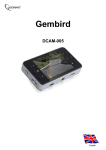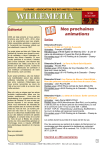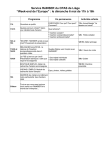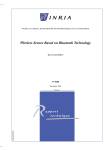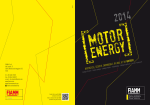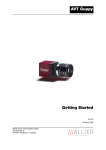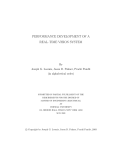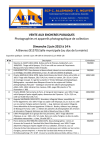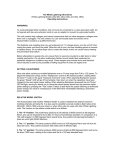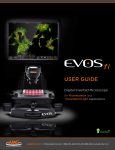Download Infrastructure of the GrImage Experimental Platform: the Video
Transcript
INSTITUT NATIONAL DE RECHERCHE EN INFORMATIQUE ET EN AUTOMATIQUE Infrastructure of the GrImage Experimental Platform: the Video Acquisition Part Bertrand HOLVECK, Hervé MATHIEU N° 0301 November 2004 THEME Cognitive systems ISSN 0249-0803 apport technique INRIA Infrastructure of the GrImage experimental platform: the video acquisition part Bertrand HOLVECK, Hervé MATHIEU Theme: Cognitive systems - Perception, indexing and communication for images and video Technical report n° 0301- November 2004 - 52 pages Abstract: GrImage (Grid and Image) is an experimental platform for the virtual reality domain. It is located at INRIA Rhône Alpes. GrImage is a test-bed dedicated to interactive applications. GrImage aggregates commodity components for high performance video acquisition, computation and graphics rendering. The video acquisition system consists of 25 cameras, connected to 12 computers. The camera placement allows the acquiring of a 2 m by 2 m by 2 m volume space. A typical application consists in: (1) doing an acquisition from multiple views of a human; (2) extracting the human visual hull, for instance, by using a background subtraction algorithm; and at the end (3) processing the immersion of the virtual human visual hull into a virtual world. The video acquisition system presents some interesting challenges: (1) to get the system real-time; (2) to get a high frame rate acquisition; (3) to warranty high quality images; (4) to be easy to install and to maintain. We present in this document the full description of the video acquisition system. It aims to share our knowledge with others similar projects, to help people working on this experimental platform to understand the system, but also to help maintain the system itself. Keywords: camera, lens, FireWire, CameraLink, synchronization Unité de recherche INRIA Rhône-Alpes 655, Avenue de l’Europe, 38330 Montbonnot-St-Martin (France) Téléphone : +33 4 76 61 52 00 – Télécopie : +33 4 76 61 52 52 Infrastructure of the GrImage experimental platform: the video acquisition part Thème : système cognitif- Synthèse d'images, réalité virtuelle, vision par ordinateur et robotique Rapport technique n° 0301- Novembre 2004 - 52 pages Résumé: GrImage (Grid and Image) est une plateforme expérimentale en réalité virtuelle. Elle se situe à l’INRIA Rhône Alpes. Cette plateforme est constituée de trois sous ensembles. La partie acquisition vidéo composée de 25 caméras, une partie dédiée au calcul composée de 25 ordinateurs, et enfin une partie dédiée au rendu graphique composée d’un mur d’images basé sur 16 vidéo projecteurs. L’application type de cette plateforme peut être décrite par les trois phases suivantes : une acquisition multiple d’images d’un personnage est réalisée, puis des algorithmes extraient l’enveloppe visuelle de ce personnage, par exemple en séparant dans les images le personnage de l’environnement (le fond), puis le modèle de ce personnage est plongé dans un monde virtuel, mis en scène sur le mur d’image. Réaliser la partie acquisition vidéo pose certains challenges intéressants. Il faut faire un système qui fonctionne à une cadence vidéo, qui garantisse une très bonne qualité de données, et enfin qui soit simple et robuste. Nous présentons dans ce document ce système d’acquisition vidéo. Ce document a plusieurs buts : tout d’abord de partager notre expérience dans ce domaine, mais aussi de servir de manuel d’utilisation et de manuel de support. Mots clés: caméra, objectif, FireWire, CameraLink, synchronisation INRIA Authors: Bertrand Holveck Research Engineer at INRIA Rhône-Alpes Software development Email: [email protected] Web home page: http://www.holveck.net Hervé Mathieu Research Engineer at INRIA Rhône-Alpes Hardware & Software systems integration Email: [email protected] Web home page: http://www.inrialpes.fr/sed/people/mathieu/Welcome.html RT N° 0301 Contents Infrastructure of the GrImage Experimental Platform: the Video Acquisition Part ............................................... 1 1 Introduction .................................................................................................................................................... 3 2 The cameras and acquisition boards description ............................................................................................ 3 2.1 The CameraLink based system.............................................................................................................. 4 2.1.1 The CameraLink standard ................................................................................................................. 4 2.1.2 The camera JAI CV-M7+CL ............................................................................................................ 6 2.1.3 The acquisition board (ARVOO LEONARDO) ............................................................................... 7 2.2 The FireWire based system ................................................................................................................... 8 2.2.1 The IEEE 1394 Bus........................................................................................................................... 8 2.2.2 The camera SONY DFW VL500.................................................................................................... 10 2.2.3 The camera SONY DFW X700 ...................................................................................................... 11 2.2.4 The camera POINT GREY DRAGONFLY.................................................................................... 12 2.2.5 The camera AVT MARLIN 046C .................................................................................................. 13 2.3 Note on the BAYER filter layout ........................................................................................................ 15 2.4 The summary of the cameras characteristics ....................................................................................... 16 2.5 The camera lenses................................................................................................................................ 16 2.5.1 How to choose the lenses? .............................................................................................................. 16 2.5.2 Testing the lenses ............................................................................................................................ 18 2.6 The lighting of the scene ..................................................................................................................... 21 3 The synchronization of the cameras............................................................................................................. 21 3.1 Why do we need to synchronize the cameras? .................................................................................... 21 3.2 The synchronization module specification .......................................................................................... 22 3.3 The different solutions......................................................................................................................... 22 3.3.1 The full FireWire solution............................................................................................................... 23 3.3.2 The solution based on an electronic box (pulse generator) ............................................................. 23 3.3.3 The solutions based on a computer (PC)......................................................................................... 24 3.3.4 The comparison of the different systems ........................................................................................ 26 3.4 The experimental setup to test the cameras’ synchronization ............................................................. 27 4 The cameras’ placement............................................................................................................................... 29 4.1 The cameras’ position in the room ...................................................................................................... 29 4.2 The rig of the two CameraLink cameras ............................................................................................. 29 4.3 The triplet of cameras for the OCETRE project.................................................................................. 29 5 Conclusion.................................................................................................................................................... 30 6 Annexes........................................................................................................................................................ 31 6.1 IEEE 1394: Bandwidth requirements for different video modes ........................................................ 31 6.2 The synchronization cable description (External trigger feature) ....................................................... 32 6.3 IMATRIG-I and the add-on electronic circuitry ................................................................................. 35 6.4 The pulse generator based on the RENESAS H8/3664F microcontroller........................................... 37 6.4.1 Overview......................................................................................................................................... 37 6.4.2 The device description .................................................................................................................... 37 6.4.3 The bill of material.......................................................................................................................... 39 6.5 The interconnection card for the external trigger ................................................................................ 40 6.6 The mechanical description of the camera support ............................................................................. 41 6.7 The dealers and prices lists.................................................................................................................. 43 7 Bibliography................................................................................................................................................. 44 INRIA Infrastructure of the GrImage experimental platform: the video acquisition part 3 1 Introduction GrImage [web_1] (Grid and Image) is an experimental platform for the virtual reality domain. It is located at INRIA Rhône Alpes [web_2]. GrImage (Grid and Image) is a test-bed dedicated to interactive applications. GrImage aggregates commodity components for high performance video acquisition, computation and graphics rendering. The computing power is provided by a cluster of PCs, with some of them dedicated to video acquisition and others to graphics rendering. A set of digital cameras enables real time video acquisition. The main goal is to rebuild in real time a 3D model of a scene shot from different points of view. A display wall built around commodity video projectors provides a large and very high resolution display. This display wall is built to enable stereoscopic projection using passive stereo. The main goal is to provide a visualization space for large models and real time interaction. This document aims at giving the complete hardware specification for the video acquisition setup. The specification consists of the following features: • It describes the camera technologies, the video acquisition board technologies, and the software used to control the hardware. It gives the benefits and the limitations for the experimental platform. • It presents also the electronic and the mechanic parts developed to make the acquisition system work. • The full description of the cables which connect all the hardware is given. • The hardware references, prices and local dealers coordinate and listed. At the end, this document may be used to understand how the acquisition system is made, but also to repair the system when a problem occurs. Note: Most of the figures appearing in this document have been extracted form the product datasheets. This document do not aim at replacing the product datasheets, it gives the technical information that is useful to understand the experimental test bed. The user must refer to the original datasheets, which are referenced in the bibliography for a full description. Also, this document describes the experimental platform at the publishing date. Then it is obvious that the experimental platform will change over the time, for instance by adding new kind of cameras. 2 The cameras and acquisition boards description The description is split according the technologies used. First, we detail the CameraLink based system, then the FireWire based system. For each technology we detail the cameras installed, their inputs and outputs, and the mode how the external trigger is used. The external trigger purpose is described in section [3]. In this section we discuss also the camera lens specification. A test aiming to evaluate the camera lens is detailed. The lighting installed in the platform is given at the end of the section. RT N° 0301 4 Bertrand Holveck, Hervé Mathieu 2.1 The CameraLink based system 2.1.1 The CameraLink standard The Evolution of Camera Link In late 2000, it became apparent to industrial camera manufacturers and frame grabber manufacturers alike, that customers were experiencing great difficulty interfacing cameras and frame grabbers. An ad-hoc committee was formed to investigate the possibility of developing a standard camera/frame grabber interface specific to the vision industry. The result of that investigation is the Camera Link standard [doc_1]. This new specification defines: • A standard connector that will be used on both the camera and the frame grabber • A standard cable to connect the camera and grabber • Formats for transmitting image data from the camera to the grabber • Four standard camera control inputs • A standard method for transmitting serial communication data between the camera and the grabber • A standard chip set that will be used in the camera and the grabber for image data transfer The Channel Link Chip Set In recent years, RS-644 LVDS technology has been used to transfer digital data. With RS-644 LVDS, a pair of wires is needed to transmit each data bit. This leads bulky cables that are expensive, prone to breakage and difficult to interface. Also, the maximum data rate in a typical camera application was limited to about 400 Mega_Bits/sec. Camera Link is based on the new Channel Link LVDS chip set manufactured by National Semiconductor. A Channel Link chipset consists of a transmitter and a receiver and is used to transfer digital data. This technology offers many advantages over the RS-644 LVDS technology. With Channel Link, 28 bits of data are transferred over just 4 pairs of wires and a fifth pair is used to transfer a required clock signal. This compares very favorably with the 56 wires that would be needed with RS-644 LVDS to do the same job. Channel Link is also capable of much higher data rates than standard LVDS. A single chipset can transfer up to 2.38 Giga_Bits/sec and the Camera Link standard allows the use of up to two chip sets. This high bandwidth capability is more than enough for current needs and allows for future expansion. CameraLink is obviously the best today in terms of performance to connect a camera to a frame grabber. The major drawback of this technology is its cost. The cost is much higher than a FireWire system. The technical information useful for the experimental setup is given in figures [Figure 1] [Figure 2] and table [Table 1]. Figure 1: The CameraLink connector shape INRIA Infrastructure of the GrImage experimental platform: the video acquisition part Table 1: The CameraLink connector pin out Figure 2: The CameraLink camera to frame grabber connector description RT N° 0301 5 6 2.1.2 Bertrand Holveck, Hervé Mathieu The camera JAI CV-M7+CL Among the different cameras existing on the market, we chose the JAI [web_5] CV-M7+CL [doc_4]. This camera is interfaced by two connectors: (1) the CameraLink connector described above [Figure 1] and (2) the Hirose 12-points connector described in [Figure 3]. According to the camera datasheet, the CameraLink external trigger mode used is named “Edge Pre-select” [Figure 4]. The signal polarity can be inverted. Both TTL and LVDS input may be used, but in an exclusive way. The other signals appearing in [Figure 4] are internal signals. Please refer to the camera datasheet [doc_4] for the details. Because the LVDS connector is only accessible through the acquisition board, we chose the TTL signal to propagate the external trigger signal. Figure 3: The CV-M7+CL Hirose connector description The cable pin out connecting (1) the camera, (2) the PC and (3) the synchronization card is given in the [Table 15] located in Annex [6.2]. Figure 4: The CV-M7+CL external trigger timing INRIA Infrastructure of the GrImage experimental platform: the video acquisition part 2.1.3 7 The acquisition board (ARVOO LEONARDO) The CameraLink protocol is not supported on actual PC mother boards. An acquisition board must be installed in the PC to interface the camera. The most difficult task was to find out on the market a CameraLink board supported by the Linux operating system. The LEONARDO [doc_2] [doc_3] line is the real solution for ultra fast CameraLink digital video acquisition and real-time processing of the incoming video data. The product line comes in several formats: PCI, CompactPCI and PMC. The LEONARDO is equipped with a state of the art Xilinx FPGA, offering real-time preprocessing of the video data, such as e.g. contrast stretching in gray value domain, RGB mosaic color restoration and random 2D convolution filters. The LEONARDO CL family is supported on Windows, Linux, Real-time Linux, Solaris and QNX. The model (PCI64-CL-FL-X100-C-128) we installed has the following features ([Figure 5]): • Bus PCI. • CL: CameraLink. • FL: FL - CameraLink Base-Medium-Full support. • X100C: Xilinx Virtex-E XCV100E mounted. • C: commercial temperature range. • 128 Mega Bytes SDRAM on board. Figure 5: System overview of the Leonardo CL digital video processor RT N° 0301 8 Bertrand Holveck, Hervé Mathieu 2.2 The FireWire based system 2.2.1 The IEEE 1394 Bus IEEE 1394 [web_6] is the designation for a standard, high-performance serial bus. The bus design originated with Apple Computer as a diagnostic tool. The bus architecture is trademarked by Apple under the name "FireWire". In 1995, the Institute of Electrical and Electronics Engineers standardized the specification for the bus. The specification number was 1394 - hence the name IEEE 1394. Some of the basic features of the bus are: • • • • • • • A data rate of up to 400 Mbps (this is expected to increase in the near future). A packet based transmission protocol. Designed with multimedia in mind. Uses standard cables and connectors defined in the specification. Supports hot plug and unplug. Support multiple devices within the same bus. The power supply may be provided through the cable. The specification is 8-40 volts and up to 1.5 amperes. The 1394 Trade Association and the Digital Camera Specification The 1394 Trade Association was formed to encourage the growth of devices that use the 1394 bus. Working groups of industry-experienced volunteers developed specifications by consensus based on the expertise of the participants. In 1998, a working group of the association issued the 1394-based Digital Camera Specification (current version is 1.30) (ref [doc_5]). The specification defines: • A number of standard features and how those features should be implemented in the camera • A number of standard video formats and frame rates • A flexible video format that allows for variable image sizes and frame rates • An external triggering method In essence, the 1394 TA Digital Camera Specification (DCAM Spec [doc_5]) defines the standard features and characteristics of an industrial camera that is capable of operating on an IEEE 1394 bus. The specification maintains flexibility by giving manufacturers the ability to add "special features" within a framework defined by the specification. The trade association also periodically refines the specification to meet current and future user needs. About the FireWire cables • Exceeding the 4.5 meter cable length! (From UNIBRAIN web site [web_9]) UNIBRAIN FireWire cables do not only achieve a very controlled 110 Ohm impedance but also provide high performance for skew, attenuation and crosstalk. These latest features were not prerequisites when the first IEEE-1394/1395 specification was issued, at the time limiting the maximum cable length to 4.5 meters. Therefore we can now secure safe operation of our FireWire cable lengths up to 10 meters. • Common rules for a FireWire network: o Never exceed 63 nodes per bus. o Never create a loop. o Extend the cable length (more than 10m) using a repeater. o Allow a maximum of 16 cables between any two nodes. o Allow a maximum of 72 meter (cumulated cable lengths) between any two nodes. INRIA Infrastructure of the GrImage experimental platform: the video acquisition part 9 The DCAM Advantages Users of industrial cameras compliant with the DCAM Spec will realize a number of benefits. First, since the cameras comply with a common standard, they are essentially plug and play. Many of the integration issues normally associated with using cameras from different manufacturers are avoided. Second, since the connectors, cables, and hubs used on the 1394 bus are all standardized, they are widely available from a number of manufacturers and are inexpensive. Finally, a simple, inexpensive interface board is used to interface the camera with the host PC. This eliminates the need for an elaborate frame grabber and does away with the problems often associated with integrating a camera and a frame grabber. The DCAM video formats The DCAM standard defines a certain number of images format. In fact it supports threes full defined video format: • Format 0 VGA (up to 640x480) non-compressed format. • Format 1 Super VGA (up to 1024x768) non-compressed format. • Format 2 Super VGA (up to 1600x1200) non-compressed format. A third format (Format_7) is defined for Partial Image Size, but it is used by the camera makers to implement their own format. Each format includes up to 8 Modes. Each Mode specifies the images size, the pixel type, the frame rate, etc. A table in the annex [6.1] gives the characteristics of the different formats & modes. Some adjustable features are also defined in the DCAM specification: Brightness, Auto Exposure, Sharpness, White Balance, Hue, Saturation, Gamma, Shutter, Gain, Trigger Mode, Zoom, Pan, Tilt, Optical Filter. Please refer to the DCAM specification [doc_5] for a complete description. The External Trigger mode In the experimental setup, the external trigger used is compliant with the DCAM 1.3 mode_0 Trigger. The state machine associated may be described as follows: • Start at the falling edge on the input signal, • The exposure period is pre-set in a register. RT N° 0301 10 2.2.2 Bertrand Holveck, Hervé Mathieu The camera SONY DFW VL500 The SONY DFW VL500 [doc_6] is the first industrial camera based on the FireWire which delivers non compressed video data. This camera is interfaced by two connectors: (1) the FireWire connector and (2) the Hirose 4-points connector. Both are described in [Figure 6]. Figure 6: The SONY DFW VL500 connectors shape & pint out - HIROSE 4 pts (Left), FIREWIRE (Right) The extern trigger timing is described in [Figure 7]. Figure 7: The SONY DFW VL500 extern trigger timing chart As shown in the above figure, the extern trigger pipeline is synchronously attached to the VD signal. This makes the system particularly inefficient when using the extern trigger mode. In conclusion this camera should not be used in extern trigger mode. INRIA Infrastructure of the GrImage experimental platform: the video acquisition part 2.2.3 11 The camera SONY DFW X700 The SONY DFW X700 [doc_7] is the next generation of the SONY FireWire based camera. The enhancements are as follows: • The resolution is 1024 by 768. • The internal architecture allows approaching 15 Hertz video rate when using the external trigger mode. This camera is interfaced by two connectors; (1) the FireWire connector and (2) the Hirose 4-points connector. Both are described in [Figure 6] (same as the DFW VL500). The external trigger timing is described in [Figure 8]. Figure 8: The SONY DFW X700 external trigger timing chart RT N° 0301 12 2.2.4 Bertrand Holveck, Hervé Mathieu The camera POINT GREY DRAGONFLY The POINT GREY Research [web_7] company is located in Canada. The DRAGON FLY product family is based on SONY CCD image sensors [Table 7]. When purchased, the camera was almost the first FireWire non-SONY high quality camera on the market. The DRAGON FLY camera [doc_8] is delivered as an OEM type format (default configuration). But a dedicated box container may be purchased, thus making a real end-product [Figure 9]. The inputs-outputs connections are very basic. [Figure 10] shows the FireWire connector and the 2x3 jumper used for the external trigger plug. Pins GN (ground) and IO2 (signal) are used for the trigger input. Figure 9: Picture of the DRAGON FLY camera Figure 10: Rear view (top) & 2x3 jumper pin out (Bottom) of the DRAGON FLY INRIA Infrastructure of the GrImage experimental platform: the video acquisition part 13 The external trigger timing is described in [Figure 11]. Figure 11: The POINT GREY DRAGONFLY external trigger timing chart 2.2.5 The camera AVT MARLIN 046C Allied Vision Technologies (AVT) [web_10] is a German company. The MARLIN product family is based on SONY CCD image sensors [Table 7]. The AVT MARLIN 046C [doc_9] [Figure 12] resolution is 780x580 pixels (in format_7). Figure 12: Picture of the AVT MARLIN camera The main advantage of this camera is to provide a frame rate over 30 Hertz and a resolution over the VGA format (640x480). This camera is interfaced by two connectors [Figure 13]; (1) the FireWire connector and (2) the Hirose 12points connector. The Hirose 12-points pin out is described in [Table 2]. Two LEDs provide a fast way to check the camera. The green LED indicates that the camera is being supplied with sufficient voltage and is ready for operation. The yellow LED indicates the states & errors described in [Table 3]. Please refer to [doc_9] for the description of the error display protocol. RT N° 0301 14 Bertrand Holveck, Hervé Mathieu Figure 13: The rear view of the AVT MARLIN 046C Table 2: The Hirose 12-points pin out Table 3: The yellow LED indication The external trigger is compliant with the DCAM specification. The important value to notice is the bounded delay between the trigger input signal and the exposure start. This time value is 32.17 micro-seconds. INRIA Infrastructure of the GrImage experimental platform: the video acquisition part 15 About the FireWire transmission format: The MARLIN 046C resolution is not classified into the video modes described within the DCAM specification (Annex [6.1]). Therefore the format 7, which is not bounded in terms of specification, must be used to get the full resolution. Otherwise, a 640x480 image resolution is acquired. Note that the external trigger input is not a true TTL input, but an optocoupler based input. Thus the current consumption is higher (between 5 mA and 15 mA). This feature impacts the design of the external trigger hardware. For instance a trigger signal output (on the PC side) drives less optocoupler inputs than true TTL inputs. 2.3 Note on the BAYER filter layout There are two kinds of color cameras: 1. The tri-sensors (tri-CCD or tri-CMOS) camera implements three image sensors and an optical prism which aims to split the incoming image in three identical images, one for each image sensor. Each image sensor is coated with a primary filter (Red, Green, and Blue). The tri-CCD camera has a better quality and is more expensive. 2. The mono-sensor camera is based on a black & white camera. The primary filters (Red, Green, and Blue) are placed over the individual pixels in a “BAYER” mosaic” layout. Figure 14: The BAYER decoding All the color cameras in the platform are based on the BAYER mosaic. Then the BAYER decoding takes place either on the camera or on the remote PC. In the first case the output format is in the color YUV 4:1:1 or the color YUV 4:2:2 [doc_5]. The image is directly usable by the computer, but the bandwidth used on the FireWire bus is higher. In the second case the output format is Y (8 bits). The computer has to perform the BAYER decoding, but the bandwidth on the bus is lower. This mode is also useful to implement an advanced BAYER decoding algorithm. RT N° 0301 16 Bertrand Holveck, Hervé Mathieu 2.4 The summary of the cameras characteristics BAYER (on-board, remote) Resolution Image / second Images/sec with extern trigger Extern trigger signal CV-M7+CL On-board or remote 1380x1030 24 24 – exposure time DFW-VL500 On-board 640x480 30 15 DFW-X700 On-board 1024x768 15 15 – exposure time DRAGONFLY DRAGONFLY MARLIN 046C BW (not color) Remote 640x480 30 30 – exposure time 640x480 30 30 – exposure time On-board or remote 780x582 54 54 – exposure time (Y 8) and 36 - exposure time in (YUV 4:2:2) 1) TTL level, negative polarity. 2) LVDS level, negative polarity. Pulse width above 80 micro sec TTL level, negative polarity, pulse width above 1 ms TTL level, negative polarity, pulse width above 1 ms TTL level, negative polarity, pulse above 1 micro second TTL level, negative polarity, pulse above 1 micro second TTL level, negative polarity, pulse above 2.2 micro second Table 4: The principal characteristics of the cameras The cameras may not achieve the indicated frame rates if some parameters are not set properly. For instance a large exposure time will slow down the frame rate. Except for the SONY DFW-VL500 and the SONY DFW-X700 the external trigger pulse width is less than 100 micro seconds. It is a bit strange why the pulse has to be so large for the SONY cameras! 2.5 The camera lenses The SONY DFW VL500 which comes with a 5.5-64 mm zoom. The POINT GREY DRAGON_FLY comes with “low cost” lenses (3.8, 6 and 8 mm focal length), but it may be replace by a CS mount. The others cameras come without lenses. This section discusses the lenses mounted on the cameras including the lenses delivered with the DRAGON_FLY camera. 2.5.1 How to choose the lenses? A common feature of the lens mounted is the mount which is a C or CS mount type. [Table 5] gives the main features or the C & CS mount specification. C mount CS mount Flange back focal length (mm) 17.526 12.5 Diameter of screw thread (mm) 25.4 32TPI 25.4 32TPI Table 5: C & CS mount characteristics Note: A CS-mount lens does not fit a C-mount camera. A C-mount lens can fit a CS-mount camera by adding a 5mm ring (C-mount adapter). INRIA Infrastructure of the GrImage experimental platform: the video acquisition part 17 The first parameter to take into account is the focal length. The couple “focal length” and “image sensor dimensions” gives the field of view. In our case, the room is about 5 meters by 5 meter, and the scene of interest is bounded in a 2 m x 2 m x 2 m cube. Given these data [Figure 15] and [Table 6] show how to calculate the focal length. At the end a focal length between 6 mm and 8mm is consistent. Image Sensor dimension (w x h) (diagonal) (mm) Classification name Focal 6 mm Angle of view (deg.) Focal 6 mm Field of view at 3 meter (m x m) Focal 8 mm Angle of view (deg.) Focal 8 mm Field of view at 3 meter (m x m) Focal 12.5 mm Angle of view (deg.) Focal 12.5 mm Field of view at 3 meter (m x m) Figure 15: The angle of view and the field of view 3.6 x 2.7 (4.5) 4.8 x 3.6 (6.0) 6.4 x 4.8 (8.0) 8.8 x 6.6 (11.0) ¼” 1/3” ½” 2/3” 33.4 x 25.4 43.6 x 33.4 56.1 x 43.6 72.5 x 57.6 1.8 x 1.3 2.4 x 1.8 3.2 x 2.4 4.4 x 3.3 25.4 x 19.2 33.4 x 25.4 43.6 x 33.4 57.6 x 44.8 1.3 x 1.0 1.8 x 1.3 2.4 x 1.8 3.3 x 2.4 16.4 x 12.3 21.7 x 16.4 28.7 x 21.7 38.8 x 29.6 0.8 x 0.6 1.2 x 0.8 1.5 x 1.2 2.1 x 1.6 Table 6: The angle of view & field of view for the image sensors Camera CV-M7+CL DFW-VL500 DFW-X700 DRAGONFLY B&W DRAGONFLY COLOR MARLIN 033C MARLIN 046C Image sensor classification 2/3” 1/3” ½” 1/3” 1/3” ½” ½” Image sensor reference Lens Mount SONY IT CCD (ICX285AQ) SONY IT CCD (ICX084AK) SONY IT CCD (?) SONY IT CCD (ICX424AL) SONY IT CCD (ICX424AQ) SONY IT CCD (ICX414AQ) SONY IT CCD (ICX415AQ) C C C CS C CS C C Table 7: The image sensor & lens mount features RT N° 0301 18 Bertrand Holveck, Hervé Mathieu Then other parameters have to be evaluated: • The distortion: the distortion correction is easily computable, but most of people do not like to deal with it. Therefore it is obvious that 8 mm must be preferred (versus 6 mm) when possible. • The spectral transmittance specifies the color reproduction. This is the value for light frequency (a function of time). This parameter is important when working with color cameras, and is very important when working with tri-CCD color cameras. When using B&W cameras, this parameter gives also the amount of light energy lost though the lens. • The Modular Transfer function (MTF) shows the delineation performance. This is the value for the spatial frequency (a function of length). This parameter is today crucial because of the high resolution image sensor. A low MTF acts as a low pass filter on the image. Lens maker Lens Ref. FUJINON PENTAX SCHNEIDER COMPUTAR PENTAX DF6HA-1 H612A-TH CINEGON 1.4/8.0MM M0814MP C814-TH Focal length (mm) 6 6 8 8 8 Mega pixels yes no no yes no Spectral transmittance & MTF data yes yes yes no yes Price (Euros) 200 168 700 230 517 Table 8: A list of suitable lenses More about the Modulation Transfer Function (MTF): The MTF is a technical term that quantifies how well a particular system propagates information. For cameras, the “system” is the lens and the sensor, and the "information" is the picture they are capturing. MTF ranges from zero (no information gets through) to 100 (all information gets through), and is always specified in terms of information density. In most imaging systems, the MTF is limited by the performance of the imaging lens. A lens must be able to transfer enough information to the image sensor to be able to resolve details in the image that are as small as the pixels in the image sensor. A practical example with a 12-micron pitch image sensor: The pixels are set on a 12-micron pitch (the center of one pixel is 12 microns from the center of its neighboring pixel). Thus, a lens used should be able to resolve image features as small as 12 microns. Typically, a lens' MTF is plotted as a function of the number of line pairs per millimeter the lens is attempting to resolve (more line pairs per millimeter mean higher information densities). For an electronic imaging system, one line pair will correspond to two image-sensor pixels (each pixel can resolve one line). This is equated as: LP/mm = 1/(2z), where LP/mm means line pairs per millimeter and z is the image sensor's pixel pitch, in millimeters. In our case, z = 0.012 mm, such that the sensor has 42 LP/mm. Thus, a lens should provide an acceptable level of MTF all the way out to 42 LP/mm. For most lenses, the MTF will be highest in the center of the images they form, and gradually drop off toward the edges of the images they form. As well, MTFs at low values of LP/mm will generally be larger than MTFs at high values of LP/mm. One of the many tradeoffs that must be decided by the end user is how high the MTF needs to be for a particular imaging situation. Generally, near an image sensor's LP/mm good MTFs are higher than 40, moderate MTFs are from 20 to 40, and poor MTFs are less than 20. 2.5.2 Testing the lenses Getting the full information of the lens is a big issue. Some lenses makers provide the lens datasheets on the web, others on demand, and some of them do not provide any datasheet at all. And when considering the camera plus the lens plus the scene, then it is a real problem to know what will happen in terms of image quality. In conclusion, we decided to evaluate by our self the system (camera + lens + scene) performance by running two tests. The “scene” represents the room including the lighting where the experiment takes place. The lens and the camera sets are listed in [Table 9]. INRIA Infrastructure of the GrImage experimental platform: the video acquisition part 19 The first test consists in shooting the scene in the same conditions than during the real application. This test aims to evaluate the camera sensibility, the lens distortion, the field of view, and the global image quality. The second test consists in shooting a dedicated pattern [Figure 16]. The test takes place in a room where the lighting is controlled. This test aims to measure the system (camera + lens) resolution, and to evaluate the color response of the system. The [Figure 17] shows the dedicated pattern used for the second test. The three areas highlighted in [Figure 17] have been used to evaluate the criteria shown in [Table 9] as follows: • The upper area for the distortion parameter. • The middle area for resolution parameter. • The lower area for the grayscale response. The images may be seen in the website referenced in [web_1]. The results shown in the [Table 9] shall be read as relative results. Because our test conditions are not perfect (e.g. problem to get the optimum focus…), we do not claim that our results are absolute. That is why we used symbols (++, --) for the distortion and linearity response parameters. The resolution parameter column reports the values read on the pattern. These values must be interpreted as a numbers without unit scale. Figure 16: the (camera + lens) second test overview Figure 17: The pattern used for the camera + lens test RT N° 0301 20 Bertrand Holveck, Hervé Mathieu As results: The first test shows us that a suitable lens focal length should be between 6 and 8 millimeters. The sensibility of all the cameras is sufficient for the lighting conditions. The second test results are as follows: • The BAYER structure is clearly visible on the image, when the on-camera BAYER is disabled. • The focus bag has to be tuned manually to get the sharpest image. So we never know if the optimum position is achieved. • The images acquired with C-mount lenses are much better in term of resolution than the images acquired with the “low cost” lenses like the BW38B-1000 lens, delivered with the POINT GREY DRAGON FLY camera. The [Table 9] summarizes the test results. The column “Distortion” is coded as follows; (+) low barrel distortion, (++) medium barrel distortion, (+++) high barrel distortion, (++++) huge barrel distortion. No pin-cushion distortion is noted. [Figure 18] The column “Grayscale response” represents the way the image reports a gray scale printed on the pattern. The coding rule is as follows; (-) good linearity, (--) medium linearity, (---) bad linearity. The coding rule for the resolution is: higher is better. Camera CV-M7+CL CV-M7+CL CV-M7+CL CV-M7+CL CV-M7+CL CV-M7+CL CV-M7+CL SONY X700 SONY X700 DRAGON FLY DRAGON FLY DRAGON FLY Lens reference (focal length) C-MOUNT FUJINON DF6HA-1 (6 mm) PENTAX H612A-TH (6 mm) TAMRON 219HA (8 mm) FUJINON HF12.5HA-1 (12.5 mm) PENTAX B1214D-TH (12.5 mm) KINOPTIK (12.5 mm) SCHNEIDER (17mm) FUJINON HF12.5HA-1 (12.5 mm) SCHNEIDER CINEGON (8 mm) NON C-MOUNT BOOWON B38 (3.8 mm) BOOWON B60 (6 mm) BOOWON B80 (8 mm) Distortion Grayscale response Resolution ++ ++ ++ + + none + + + ---------- 650 650 600 650 600 700 650 500 (*) 500 (*) ++++ ++ + --- 400 350 400 Table 9: the camera + lens performance test result (*): The resolution limit is due to the camera sensor used which is a 1024x768 size CCD. We may suppose that the real resolution is closed to 650. Figure 18: The barrel and Pin-Cushion distortion models INRIA Infrastructure of the GrImage experimental platform: the video acquisition part 21 2.6 The lighting of the scene The lighting of the scene is always a big issue when working with camera. We choose a professional grade lighting for minimize the problem. Basically we copy what is used in a TV studio. The [Table 10] gives the list of the part used. Name BALCAR [web_12] QuadLite BALCAR DualLite Watt 250 125 Candela 8300 3800 Quantity 7 7 Table 10: The part list of the lighting system A tubular structure hanging from the ceiling holds the lightings. Note: Several cameras are also fixed on the tubular structure. 3 The synchronization of the cameras 3.1 Why do we need to synchronize the cameras? The applications running on the GrImage test bed are mostly based on video tracking and dense stereo vision algorithms. For this class of algorithms, the image tokens are (1) tracked over the time or (2) matched across images acquired from different points of views. A tracking program using a KALMAN filter needs an image time stamp for its time reference. A process based on the matching algorithm needs to have images acquired at the same time, especially when the scene is not static. When shooting two or more images, the delta-time between the acquisitions makes unstable the token matching, and is directly connected to the 3D reconstruction uncertainty. In order to calculate an acceptable delta-time, we consider the typical scenario as follows: • A scene where a human is moving. We suppose that the maximum human’s part velocity is 10 meters per second (=v). The distance Human-camera is about 3 meters (=D). • A multi-cameras system is used. The cameras are the JAI CV-M7+CL with a 12.5mm focal length lens mounted on it. The camera resolution is 1380 by 1030 pixels. Then using the [Table 6], a pixel line represents (d = 1.6/1030) meter at the distance D. • The goal is to warranty that: for each camera, any image point represents the projection of the same 3D point. In other words, the time between two image acquisitions of two cameras must be short enough to warranty that a 3D projection point will not shift to half a pixel. As result, the delta time between two acquisitions must be less than 0.8 milli-seconds (800 micro seconds) (d / v / 2) Note that when running several cameras in free mode at 30 Hertz, the delta-time is between 0 and 33 milliseconds, with no control on it. In conclusion, the acquisition process must be mastered to bind correctly the delta-time. RT N° 0301 22 Bertrand Holveck, Hervé Mathieu 3.2 The synchronization module specification The Goal: the synchronization module specification aims to warranty that all the pictures have been acquired at the same time. We first have to think about the acquisition environment. The cameras are placed in a room. The room is 5x7 meters, and the cameras may be disposed almost everywhere in the room. To connect all the systems properly we use cable rails hanging from the ceiling. That means that the cable length between the computer and the camera may be over 12 meters. Then when considering twenty cameras, the total length of the cables may be over 100 meters. A solution consisting of a dedicated cable supplying the synchronization signal may be considered with attention to take into account this specification. Also because of the cable length and the number of cameras, the FireWire based cameras can not be connected on the same FireWire bus, so multiple FireWire busses must be used. The specifications concerning the use of the synchronization module are as follows: • The user controls the start and the stop of the video acquisition process. • The user controls the number of images acquired. For instance taking only one shoot of images, is useful to test the system or for the camera calibration process. Note that the image acquisition system has to mark a time stamp on each image, in order to trace the image along the processing, and for the storage (data logger). The synchronization module may help for this task, but is not necessary. 3.3 The different solutions We present in this section the different solutions that provide a global synchronization for all the cameras. Each of these solutions has been tested within the platform. We can find out two families of solutions. 1. The solutions based on the FireWire bus. This solution has no installation cost, because it relies on the existing cables. Two solutions exist: (1) the first one relies on a proprietary trick, and concerns only the POINT GREY cameras, (2) the second one relies on the DCAM 1.31 specification. Unfortunately only the FireWire based cameras benefit from it. And these solutions do not work when using multiple FireWire busses. All these restrictions limit the interest of these solutions in our experimental platform. 2. The solutions based on a dedicated electric signal. All the cameras used in the computer vision domain own a TTL compatible input which allows trigging externally the image acquisition. Two different solutions are presented: one based on an electronic box, and another based on a PC. Note about the solutions based on a TTL signal: All the cameras currently used own the extern trigger facility. Basically it consists in supplying an electric pulse. But several specifications do exist for the signal itself. In order to master all the different cameras the following requirements are specified: • The signal polarity may be changed. Possible values are positive or negative. • The signal width may be changed. The value is between 30 micro seconds and 2 milliseconds. • The signal period may be changed. The value is between 20 milliseconds and 100 milliseconds. We give in the next sections the detail of the different solutions. INRIA Infrastructure of the GrImage experimental platform: the video acquisition part 3.3.1 23 The full FireWire solution This method is based on the FireWire protocol and does not use the external trigger feature. Solution 1: Multiple PTGREY DRAGONFLY (and some other references) cameras on the same IEEE-1394 bus are automatically synchronized to each other at the hardware level. When using multiple cameras, the timing of one camera to another is as follows: • • If the cameras are on the same bus, the cameras are synchronized to within 125 microseconds (maximum) of each other. However the 1394 bandwidth limits the maximum number of cameras that can be on one bus. If the cameras are on separate buses, a PTGREY Sync Unit is needed to synchronize the buses. The Sync Unit can synchronize cameras on different buses within the same computer or on different buses across multiple computers. This device will ensure that the cameras are synchronized to within 125 microseconds. The major drawback is that this trick works only for the designated PTGREY FireWire based cameras. This solution has been tested but it is not used anymore within the experimental platform. Solution 2: The DCAM v1.31 is supposed to provide an equivalent method to synchronize the cameras. Unfortunately, we do not have yet tested this new feature. Indeed we have first to upgrade the embedded software inside the camera to be compliant with the new DCAM version. 3.3.2 The solution based on an electronic box (pulse generator) Two products are currently used in the lab. Product 1: We choose the product IMATRIG-I [doc_10] from the company IMASYS [web_8]. In order to be compliant with the specification we gave above, we add some electronic circuitry to achieve the two following features: • The purchased system delivers the pulse stream as soon as the power supply is plugged. We add the feature to start/stop the pulse generation. It is achieved by using an on-board button or one digital output of a PC parallel port. • The IMATRIG-I generates a pulse with a fixed width. Unfortunately the pulse width is not large enough for certain cameras. So we had a Mono-Stable component (74LS123) in order to enlarge the pulse. The annex [6.3] describes the IMATRIG-I product and gives the schematic of the electronic circuitry added. Product 2: A second electronic box is currently used. This system has been developed in the lab and is based on the RENESAS [web_13] H8/3664F microcontroller. The specification is given in annex [6.4]. The cameras are connected to the electronic box via home-made cables. The cables description is given in annex [6.2]. Using the electronic box as a trigger generator, the following system may be implemented to mark the images with a time stamp: A cable is added from the electronic box to a computer (parallel port input), so the processor receives a signal each time an acquisition trigger pulse is generated. In detail, the trigger signal is connected to an input pin of the PC parallel port. This input pin has been configured to send an interruption to the processor. Then, an interrupt handler programmed by the user, is called at every incoming pulse. The role of the interrupt handler is to store the date. Then this date is used as time stamp when the image is stored in the memory. RT N° 0301 24 3.3.3 Bertrand Holveck, Hervé Mathieu The solutions based on a computer (PC) The following scenarios have been tested: 1. Only one PC generates the trigger signal for all the cameras. 2. Any PC is in charge to generate the trigger signal. The PCs are not synchronized (main clock system) all together, but a Master-Slave protocol based on the parallel port provides an acquisition synchronization. 3. Any PC is in charge to generate the trigger signal. The PCs are synchronized using the NTP protocol. For these solutions, the parallel port is used as the hardware interface. On a PC, the parallel port may be used for digital input output. A partial specification may be summarized as follows: • The parallel port connector reference is SUB-D 25 points female. • Pin 2 up to pin 9 act as outputs and are referenced in the DATA register. • Pin 10 acts as input, and is referenced in the STATUS register. • Pin 18 to pin 25 are grounded. From the software point of view: The operating system running on the computer is Linux, and the real time module RTAI is added. The Real Time Application Interface (RTAI) [web_4] consists mainly of two parts: • A patch to the Linux kernel which introduces a hardware abstraction layer. • A broad variety of services which make real-time programmers' life easier. It is free to download and is under GPL license. A program runs to manage the synchronization. Remember that the final goal is to grab all the images within a period of 800 micro-seconds. Then Linux is not adapted for this real-time oriented task, thus justifying the use of RTAI. The code is not detailed in this document. Scenario 1: Only one PC generates the trigger signal for all the cameras. The system is equivalent to make an electronic box by using a PC. The hardware and software implementation is not detailed here. In fact it derivates from the implementation detailed within the next scenario. Scenario 2: Any of the PC is in charge to generate the trigger signal. The PCs are not synchronized all together. A PC acts as master. It generates the pulse signal to a sub-set of cameras but also it uses the same signal to synchronize the other PCs involved in the image acquisition process. From the hardware point of view, the connections on the parallel port are shown in [Figure 19]. The specification is as follows: • The upper DB25 connector highlights the pins used. As define in the parallel port datasheet, pin_2 to pin_9 are TTL outputs, pin_10 is a TTL input, and pin_18 to pin_25 are grounded. • The three others DB25 connectors are drawn to explain the strategy used. Each connector (x3 in the example) is associated with one computer. Among the three connectors, the upper one acts as the master. It provides TTL pulses (outputs pin_8, pin_7, pin_6) to the other connector (input pin_10), but also to itself. This trick is used to get the same path for all the signals, and so to take into account the transmission delay between the output and the input. Therefore the delay between all the triggers is the same. • The slave computer state machine is as follows: For each pulse received (pin_10), a TTL pulse is generated on the output pin_9 which is connected to the camera external trigger input. INRIA Infrastructure of the GrImage experimental platform: the video acquisition part 25 Figure 19: The parallel port as a pulse generator A card has been developed to facilitate the interconnections between the master and the slaves. The schematic is given in Annex [6.5]. Basically the card is composed with several connectors on a PCB. The PC acting as master is plugged on the card though a terminal blocks (Phoenix contact). On the PC side the parallel port (DB25 connector) is used. The PCs acting as slaves are plugged on the card either though a terminal block (Phoenix contact), or though two jumpers (Signal and Ground). The software requirements for the synchronization process are as follows: • To deal with the parallel port. • To implement an interrupt handler connected to the parallel port input. The interrupt handler just frees a semaphore. • To implement a high-priority task. This task is unlocked by the previous mentioned semaphore. Then it generates a controlled pulse on the parallel port output (connected to the camera trigger). Scenario 3: Each PC is in charge to generate the trigger signal. The PC’s clocks are synchronized using the NTP protocol. The implementation is the same that the scenario described above, except, that the inter PCs synchronization is supply by the NTP (Network Time Protocol). What is NTP? NTP [web_3] is a protocol designed to synchronize the clocks of computers over a network. NTP version 3 is an internet draft standard, formalized in RFC 1305. NTP version 4 is a significant revision of the NTP standard, and is the current development version, but has not been formalized in an RFC. Simple NTP (SNTP) version 4 is described in RFC 2030. NTP is a protocol built on top of TCP/IP that assures accurate local timekeeping with reference to radio, atomic or other clocks located on the Internet, or GPS (Global Positioning System). This protocol is capable of synchronizing distributed clocks within milliseconds over long time periods. NTP is benefit in the following case: Among all the PCs, some of them may be out of reach from the other PCs in terms of cable length. Then the daisy chain process described above [3.2] does not work correctly. If all the PCs are synchronized using NTP, then the acquisition process works correctly. RT N° 0301 26 Bertrand Holveck, Hervé Mathieu 3.3.4 The comparison of the different systems The Full FireWire Solution: • • • Advantages: There is no need of additional cables, additional electronics and additional software. Drawbacks: o The system only constraints the image flow in a way that the acquisition is done at the same time. But the beginning of the image capture is not under control. The consequence is that the first images coming to the system might not be taken at the same date. In other words, two image sequences may be shifted from one or more images. o It only works on one FireWire bus. In other words two cameras on the same PC but not on the same FireWire bus (controller) are not synchronized. o This system only works on some POINT GREY camera models. Remarks: A synchronization protocol based on the FireWire bus is included in the new version of the IIDC specification (version 1.31), thus the next cameras should benefit from it. Solution based on an electronic box: Product 1: the IMATRIG generator • Advantages: An industrial product specialized in trigging the cameras is a reliable generator. • Drawbacks: An external electronic card has to be developed in order to control the pulse length and to implement the start & stop feature. Product 2: the Home-made generator • Advantages: It is controlled by a serial line (RS232). It is based on a micro controller, so it is a reliable generator. • Drawbacks: Like all the home made products, this is a big issue to duplicate the system if needed. Solutions based on computers: Scenario 1: One PC generates the signal • Advantages: No need of a third party electronic system. • Drawbacks: Need to have a real time operating system installed on the PC. • Remarks: Idem to an electronic box but more encumbering. Scenario 2: Each PC generates the signal. The PCs are synchronized through the parallel port: • Advantages: Precise time stamp of the pulse. • Drawbacks: Need to have a real time operating system installed on the PC. Need to install an additional cable between each PC. If the internal clocks of the computers are not synchronized, the time stamps (absolute time) between each PC will not be the same. Scenario 3: Each PC generates the signal. The PCs are synchronized by there clock over NTP. • Advantages: Precise time stamp of the pulse. Less cables than in Scenario 2. • Drawbacks: Need to have a real time operating system installed on the PC. INRIA Infrastructure of the GrImage experimental platform: the video acquisition part 27 3.4 The experimental setup to test the cameras’ synchronization The issue is to know if the system is working as we want. We describe in this section the experiment which aims to validate that all the images are grabbed within the specified period (800 microseconds). The experiment is independent of the technology used for the synchronization process. But the following description concerns a system based on PCs, part of them connected to a NTP server. The experimental setup is described in [Figure 20] and [Figure 21]. It consists of four cameras, three computers (PC), a NTP server, and a CRT display. The topology is as follows: • Two cameras are connected to the first PC which also provides the external trigger. • The third camera is connected to the second PC. This PC receives the timing form the first PC, and provides the external trigger for the connected camera. • The fourth camera is connected to the third PC. This PC provides the external trigger. • The first and the third PCs are synchronized using a NTP server. • The four cameras are set in front of the CRT screen. The CRT screen displays a test pattern [Figure 22]. The CRT screen has an update frequency of 85 Hertz, for a 1024x768 resolution display. The resulting period for a line is around 14 microseconds. Figure 20: The experimental setup (schematic) RT N° 0301 28 Bertrand Holveck, Hervé Mathieu Figure 21: The experimental setup (view) Figure 22: The test pattern displayed on the CRT screen & resulting (reduced) images acquired INRIA Infrastructure of the GrImage experimental platform: the video acquisition part 29 The experiment runs as follows: • A program which aims to acquire four synchronous images is launched. • The four cameras receive the external trigger and shoot an image. The exposure time (500 micro seconds) in set in order that the CRT screen displays only few lines (around 10) during this period. At the end only a thin horizontal strip is highlighted in the image. • By looking the four images, it is straight forward to identify the pattern located in the horizontal strip highlighted. By comparing the pattern in the four images, we measure the delay between the acquisitions. • We run several times the experiment program in order to get a valuable set of data. The results are conformed to the specified delay. The average delay is around 20 microseconds. 4 The cameras’ placement 4.1 The cameras’ position in the room The global cameras’ positioning aims to provide: • A working volume as large as possible. • A maximum of point of views. Several parameters limit the positioning: • The room size is about 7 m x 5 m. • The ceiling is 3 m height. • We must minimize the distortion in the image, therefore too-short focal length lenses must be discarded. The tests done show that a 6 mm focal length is the minimum for an acceptable image distortion. 4.2 The rig of the two CameraLink cameras The CameraLink cameras purpose is the stereo vision process. It supposes to have a rigid link between both cameras. A structure based on aluminum is used. 4.3 The triplet of cameras for the OCETRE project The OCETRE project [web_11] is a project hold by several research teams and industrial companies. The experimental setup for this project is considered as a sub system in the GrImage platform. Therefore it benefits from the development done within the GrImage platform. Basically, the required hardware consists of 3 video acquisition systems each one composed of 3 cameras rigidly attached. The system is supposed to be low cost. We designed two holders for the triplet of cameras. The first holder consists of off-the-shelf parts. The [Table 11] gives the parts list. The [Figure 23] shows the system. Reference MANFROTTO column #190 MANFROTTO extra support #840 MANFROTTO 3/8 ¼ adapter #120 MANFROTTO micro ball head #482 Quantity 4 8 12 12 Table 11: The off-the-shelf based mount part list RT N° 0301 Price per unit (Euros) 738 31 25 15 30 Bertrand Holveck, Hervé Mathieu Figure 23: View of the OCETRE system A second holder is a home made version. It consists of the following parts: • A 22 mm x 22 mm extruded aluminum profile. Its length gives the maximum baseline between two cameras. • 3 brackets to interface the profile and the camera. • A home made mechanical part to interface a standard camera tripod with the holder. • 5 M5x8 screws and 1 ¼” nut (Standard camera threaded hole) for assembling the parts. The technical drawing and the material list are presented in annex [6.6]. This version is cheaper. 5 Conclusion We successfully developed a multi camera system. The system is based on the digital technologies CameraLink and FireWire. It is the first large acquisition system developed in the lab based only on digital technology. The contributions of the document are as follows: • It gives an exhaustive list of the component used within the system. • The useful technical information has been extracted from the complete documentation, thus making a kind of global technical manual for the whole system. • New challenges have been addressed: (1) the limit of the lens technologies for the mega-pixels cameras; (2) the different strategies to trig the cameras. • All the home made parts have been detailed. Because the platform is an experimental test bed, new products will update the whole system. Then the document will lack of the new information. However, the technologies we choose, the problems we address, will be the same. INRIA Infrastructure of the GrImage experimental platform: the video acquisition part 31 6 Annexes 6.1 IEEE 1394: Bandwidth requirements for different video modes The video modes as defined by the "IIDC 1394-based Digital Camera Specification" (DCAM) require different bandwidths as shown in the table below. The values are based on a 400 Mega_Bit/s connection and are rounded. Bit/Pixel Video Format Format_0 Format_1 Format_2 60 fps 30 fps 15 fps 7.5 fps 3.75 fps 1.875 fps Mode_0 160 x 120 YUV (4:4:4) 24 6% 3% 2% Mode_1 320 x 240 YUV (4:2:2) 16 16% 8% 4% 2% Mode_2 640 x 480 Y (Mono) 8 32% 16% 8% 4% Mode_3 640 x 480 YUV (4:1:1) 12 48% 24% 12% 6% Mode_4 640 x 480 Y (Mono16) 16 64% 32% 16% 8% Mode_5 640 x 480 YUV (4:2:2) 16 64% 32% 16% 8% Mode_6 640 x 480 RGB 24 96% 48% 24% 12% Mode_0 800 x 600 Y (Mono) 8 50% 25% 13% Mode_1 800 x 600 Y (Mono16) 16 100% 50% 25% 13% Mode_2 800 x 600 YUV (4:2:2) 16 100% 50% 25% 13% Mode_3 800 x 600 RGB 24 75% 38% Mode_4 1024 x 768 Y (Mono) 8 39% 20% 10% 5% Mode_5 1024 x 768 Y (Mono16) 16 77% 39% 20% 10% Mode_6 1024 x 768 YUV (4:2:2) 16 77% 39% 20% 10% Mode_7 1024 x 768 RGB 24 58% 27% 15% Mode_0 1280 x 960 Y (Mono) 8 32% 16% 8% Mode_1 1280 x 960 Y (Mono16) 16 64% 32% 16% Mode_2 1280 x 960 YUV (4:2:2) 16 64% 32% 16% Mode_3 1280 x 960 RGB 24 75% 38% Mode_4 1600 x 1200 Y (Mono) 8 50% 25% 13% Mode_5 1600 x 1200 Y (Mono16) 16 100% 50% 25% Mode_6 1600 x 1200 YUV (4:2:2) 16 100% 50% 25% Mode_7 1600 x 1200 RGB 24 75% 38% RT N° 0301 64% 100% 77% 64% 100% 32 Bertrand Holveck, Hervé Mathieu 6.2 The synchronization cable description (External trigger feature) The following four cables are presented in this annex: • The external trigger cable – master type [Table 12]. This cable connects: o The parallel port (SUBD 25 points) of a PC. The PC acts as master for delivering the synchronization pulse. o A SUBD 9 points for the camera trigger signal transmission. o A bundle of 8 wires to be connected on the interconnection card (See Annex 6.5). • The external trigger cable – slave type [Table 13]. This cable connects: o The parallel port (SUBD 25 points) of a PC. o A SUBD 9 points for the camera trigger signal transmission. o Two wires to be connected on the interconnection card (See Annex 6.5). • The trigger extender cable [Table 14]. This cable connects: o The SUBD 9 points defined within one of the two cables defined above. o Up to four cameras trigger inputs. The connectors depend on the camera. The [Table 14] shows a connection example with; two POINT GREY, one AVT MARLIN and one SONY cameras. But it can be whatever camera with a TTL compatible trigger input. • The external trigger cable for the CameraLink based system [Table 15]. The cable dedicated for the CameraLink based system is not based on the generic cables defined above. We prefer to build special cable because only two of these cameras are currently used. This cable connects: o The Hirose 12 points of the JAI camera. o The parallel port (SUBD 25 points) of a PC. o Two wires to be connected on the interconnection card (See Annex 6.5). Note about the parallel port of a PC: It may be used for digital input output. A partial specification is summarized as follows: • The parallel port connector reference is SUB-D 25 points female. • Pin 2 to pin 9 act as outputs and are referenced in the DATA register. • Pin 10 acts as input, and is referenced in the STATUS register. • Pin 18 to pin 25 are grounded. Note about the cable description: The described cables are not point to point cables. But they connect several entities together. Each entity is represented by a connector (Hirose 12 points, DB9 9 points female …). We can find out four horizontal layers in the following tables. The layers from top to bottom are defined as follows: • The length of each part constituting the cable. • The type of wires used within the cable. • The connectors. • The pin outs and the connections between the connectors. INRIA Infrastructure of the GrImage experimental platform: the video acquisition part 33 Cable length: Å---------------------------10m--------------------Æ Å-------------------1m------------------Æ - 10m (DB9f-DB25m) : cable 2x(7x0.1mm2) 28 AWG Shielded part on the DB25m shell - 1m (DB25m et x) : Ethernet cable cat5 4x2 twisted wires Shielded part of the Ethernet cable on theDB25m shell DB9 female 1 (black) 6 (white) 2 (bridge to 1) 7 (bridge to 6) 3 (bridge to 1) 8 (bridge to 6) 4 (bridge to 1) 9 (bridge to 6) DB25 male 21 9 Interconnection card 10 (blue) 22 (blue/white) 2 (orange) 3 (orange/white) 4 (brown) 5 (brown /white) 6 (green) 18 (green/white) (sync in) (ground) (sync out 1) (sync out 2) (sync out 3) (sync out 4) (sync out 5) (ground) Table 12: The external trigger cable – master type Cable length: Å---------------------------10m--------------------Æ Å-------------------1m------------------Æ - 10m (DB9f-DB25m) : cable 2x(7x0.1mm2) 28 AWG Shielded part on the DB25m shell - 1m (DB25m et x) : cable 2x(7x0.1mm2) 28 AWG Shielded part on the DB25m shell DB9 female 1 (black) 6 (white) 2 (bridge 1) 7 (bridge 6) 3 (bridge 1) 8 (bridge 6) 4 (bridge 1) 9 (bridge 6) DB25 male 21 9 Interconnection card 10 22 Table 13: The external trigger cable – slave type RT N° 0301 (sync in) (ground) 34 Bertrand Holveck, Hervé Mathieu Cable length: Å--------------0.5m-----------------Æ Å--------------------------------0.5m-----------------Æ Å----------------------------------------------------0.5m-----------------Æ Å-----------------------------------------------------------------------------0.5m-----------------Æ cable 2x(7x0.1mm2) 28 AWG DB9 male 1 (black) 6 (white) 2 (black) 7 (white) 3 (black) 8 (white) 4 (black) 9 (white) POINTGREY #1 (Jumper) 1 (ground) 2 (trig in) POINTGREY #2 (Jumper) AVT MARLIN HR 12 points SONY DFW700 HR 4 points 1 (ground) 2 (trig in) 7 (ground) 4 (trig in) 2 (ground) 3 (trig in) Table 14: The external trigger extender cable Cables length : Å-------------5 meters------------Æ Å-----------------------5meters+0.3meter---------------Æ (via DB25m) Å--------------------------------------5meters----------------------------------------------Æ Å---1meter----Æ - 5m (Hirose & DB25m) : Ethernet type cable cat5 4x2 twisted wires - 0.2m (DB25m & PC Power supply) : cable 4x(7x0.2mm2) (used by pair) - 1m (DB25m & Jumpers) : cable 3x(7x0.1mm2) (only 2 wires used) - Shielded part of the Ethernet cable on theDB25m shell HR 12points RS232 1 (ground) (blue/white) 2 (+12volts) (blue) 10 (trigger in) (brown) 12 (ground) (brown/white) 5 (ground) (green/white) 6 (RXD) (green) 7 (TXD) (orange) 8 (ground) (orange/white) Extension PC Power Supply DB25m Interconnection card (green + yellow) +(black) (red + blue) + (yellow) 9 19 TBD TBD TBD TBD 10 (red) 22 (blue) (sync in) (ground) Table 15: The external trigger cable for the CameraLink based system INRIA Infrastructure of the GrImage experimental platform: the video acquisition part 35 6.3 IMATRIG-I and the add-on electronic circuitry The [Figure 24] shows the front panel of the IMATRIG system. Figure 24: the IMATRIG-I front face (comments are in French) In the IMATRIG terminology, the MODE 4 is convenient for our application. The MODE 4 provides a periodic signal in the outputs (Marked as Sortie in [Figure 24]). The parameter switches PARAMETER1 and PARAMETER2 [Figure 25] allow tuning the output frequency of the signal. The switches act as a 16-bits word. The formula to get the pulse period is: (N1,2 + 3) x 16 µs. Figure 25: Zoom on the IMATRIG parameter switches RT N° 0301 36 Bertrand Holveck, Hervé Mathieu Figure 26: the IMATRIG-I add-on schematic INRIA Infrastructure of the GrImage experimental platform: the video acquisition part 37 6.4 The pulse generator based on the RENESAS H8/3664F microcontroller 6.4.1 Overview The camera may be triggered by an external signal to control the image acquisition. This trigger signal is generally a negative or positive pulse compatible with the TTL standard. To generate this signal we usually use a trigger generator. In our case a standard trigger generator is not convenient. For instance standard trigger generators make the pulse output active as soon as it is plugged (powered). In our system the pulse output must be totally controlled. The controls needed are listed as follows: • The pulse output stream is started or stopped by the user. • The system can send a variable number of pulses (one to infinite). • The pulse polarity may be changed. • The pulse parameters (width and period) may be changed. In the past we successfully worked with the RENESAS (formerly Hitachi) H8/3664F for applications like [web_14]. So we decided to use the same microcontroller to design the trigger generator. We present in this document: (1) a general description of the device; (2) the user manual; and (3) the cost. The detailed documentation of the device is not given is this document. [Figure 27] shows the device. Figure 27: Pictures of the trigger box 6.4.2 The device description The hardware components are the following: • The AE-3664FP board is a 40mm x 27mm module, based on H8/3664F RENESAS micro controller. • The H8 tiny I/O board (TERA2) is a development board for programming AE-3664FP module. This board is considered as a development board. Anyway it is a high quality PCB, and all the needed functionalities are present. The PCB footprint is 95 mm x 45 mm. The inputs-outputs are the following: • A SUB-D 9 pins allows connecting the device to the serial line of a PC. • A Green Led is on when the power is plugged. • A Red Led is activated when the Pulse is active. So because the pulse width is very short compared to the signal period, the light coming from the Red Led may be weak. • A Yellow Led is reserved for a future version of the device. • A terminal block receives the connections from the cameras. RT N° 0301 38 Bertrand Holveck, Hervé Mathieu The device control is achieved by using a Serial connection ([Table 16]). Data format Flow control Parity Stop bit Bit rate 8 bits None None 1 57600 bits per second Table 16: The serial line configuration The communication is based on ASCII format command ([Table 17]). Command ‘i’ ‘s’ ‘S’ ‘+’ ‘-’ ‘w’ ‘W’ ‘p’ ‘P’ ‘n’ ‘N’ ‘c’ Answer <i><module id><ok>\n\r <s><ok>\n\r <S><ok>\n\r <+><#CONFIG><ok>\n\r <-><#CONFIG><ok>\n\r <w><#CONFIG><ok>\n\r <W><#CONFIG><ok>\n\r <p><#CONFIG><ok>\n\r <P><#CONFIG><ok>\n\r <n><#CONFIG><ok>\n\r <N><#CONFIG><ok>\n\r <c><#CONFIG><ok>\n\r Meaning Return module id name (for instance “inria ra – trigger 01”) Start Stop Change the pulse polarity Change the pulse polarity Enlarge the pulse width with a constant step (0.5 ms) Reduce the pulse width with a constant step (0.5 ms) Enlarge the pulse period with a constant step (0.5 ms) Reduce the pulse period with a constant step (0.5 ms) Increment the number of pulse (0 = infinite) Decrement the number of pulse (0 = infinite) Print the configuration Table 17: The command list of the trigger generator Explanation of the “#CONFIG” term: String example: <w=2><p=35><n=0><->. The meaning is as follows: • <w=2>: is the pulse width in millisecond. • <p=35>: is the pulse period in millisecond. • <n=0>: is the number of pulses that will be produced. 0 means that an infinite number of pulses will be generated. • <->: is the pulse polarity. The character ‘–‘ means a negative pulse (+5volts -> 0volt -> +5volts). The character ‘+’ means a positive pulse (0 volt -> +5 volts -> 0volt). The following developments may be considered in the future: • A button can be added on the box. It aims to start and stop manually the signal emitting. • An interesting feature would be to synchronize several trigger generators together. For this purpose, a digital input and a digital output must be added. • In the current version all the output signals have the same polarity. The output signals could be split in negative and positive polarity signals. Then camera with negative and positive polarity trigger signal could be connected together. INRIA Infrastructure of the GrImage experimental platform: the video acquisition part 6.4.3 39 The bill of material Name Company Reference Distributor Reference Micro controller module H8 development board Software H8 Flash Toolkit GNU H8 C Renesas AE-3664FP Microtronique AE-3664FP Renesas Renesas KPIT Plastic box (ABS) Connector (socket) Connector (plug) Phoenix Contact Phoenix Contact - Microtronique HEW 2.2 FDT 2.2 wingnuh8v0303coff 120 x 65 x 40 mm MC 1,5/2-ST-3,81 MCV 1,5/2-G Radiospares Radiospares Radiospares 281-6835 220-4658 220-4822 Table 18: The bill of material of the trigger generator RT N° 0301 Qty 1 Price per Unit (Euros) 25 1 30 1 1 1 0 0 0 1 16 16 6 1.2 0.4 40 Bertrand Holveck, Hervé Mathieu 6.5 The interconnection card for the external trigger The [Figure 28] and [Figure 29] describe the home-made card developed for interconnecting the MASTER PC and the SLAVE PCs involved in the external trigger feature. The key-points of the card are as follows: • One MASTER PC (Parallel port) is plugged on the MASTER connector (Terminal Block – Phoenix Contact). • One SLAVE PC (Parallel port) may be plugged on the SLAVE connector ((Terminal Block – Phoenix Contact). • Up to five SLAVE PCs (Parallel port) may be plugged on the SLAVE jumpers. Two jumpers must be plugged for each SLAVE, one is the signal itself (sync_in), and the other is its ground part (ground). Figure 28: the interconnection card (schematic) Figure 29: The interconnection card (view) INRIA Infrastructure of the GrImage experimental platform: the video acquisition part 41 6.6 The mechanical description of the camera support The system is designed to be fixed on a standard video tripod, and to hold a set of three cameras. The [Figure 30] shows the system. The [Figure 31] gives the technical drawing to machine the home made mechanical interface between the holder and the tripod. The [Table 19] gives the part list. Figure 30: The 3-cameras holder Figure 31: The interface between the camera tripod and the home made holder RT N° 0301 42 Bertrand Holveck, Hervé Mathieu Dimensions (mm) Extruded aluminum Caps Bracket Nut Screw Home made part Nut 22 x 22 x 300 22 x 22 20 x 20 x 20 M5 M5x8 50 x 50 ¼” Reference (RADIOSPARES) 249-0073 249-0231 (for 10) 219-0398 - Number 1 2 3 4 4 1 1 Cost (Euros) per unit 20 1 4 - Table 19: The 3-cameras holder part list Some off-the-shelf parts must be machined in order to fit the system. • One of the two thru holes of the brackets receiving the cameras must be enlarge from 5mm to 6.5mm in order to fit the ¼” camera screw. INRIA Infrastructure of the GrImage experimental platform: the video acquisition part 43 6.7 The dealers and prices lists We report here the part list for the main parts. The “Small” parts are not reported. COMPANY JAI SONY SONY AVT POINTTGREY FUJINON FUJINON SCHNEIDER ARVOO UNIBRAIN UNIBRAIN - MODEL LOCAL DEALER Camera CV-M7-CL DFW-VL500 DFW-X700 MARLIN 046C DRAGON FLY Lens HF12.5HA-1 (12.5mm) DF6HA-1 (6mm) CINEGON 1.4/8.0mm Board LEONARDO PCI64-CL-FL-X100-C-128 PCI FireWire Red Cable FireWire cable - 10 meters CameraLink cable - 5 meters IMASYS ALLIANCE VISION ALLIANCE VISION IMASYS ROBOSOFT 4000 1775 2730 1100 1000 ALLIANCE VISION IMASYS IMASYS 160 200 700 ECRIN ALMA ALMA ALLIANCE VISION Table 20: The dealers and prices lists RT N° 0301 PRICE per unit (Euro) 2900 20 35 280 44 Bertrand Holveck, Hervé Mathieu 7 Bibliography [web_1] http://www.inrialpes.fr/sed/GrImage/ [web_2] http://www.inrialpes.fr/ [web_3] http://www.ntp.org/ [web_4] http://www.rtai.org/ [web_5] http://www.jai.com/ [web_6] http://www.1394ta.org/ [web_7] http://www.ptgrey.com/ [web_8] http://www.imasys.fr/ [web_9] http://www.unibrain.com/ [web_10] http://www.alliedvisiontec.com/ [web_11] http://ocetre.inrialpes.fr/ [web_12] http://www.balcar.com/ [web_13] http://www.renesas.com/ [web_14] http://www.inria.fr/rrrt/rt-0289.html [doc_1] Specifications of the Camera Link Interface Standard for Digital Cameras and Frame Grabbers PULNIX (www.pulnix.com) October 2000 [doc_2] Leonardo PCI-64CL Full, User Manual (draft, rev. B doc 1.2) ARVOO 2002 [doc_3] Leonardo PCI-64CL Full, Software Development Kit (Draft rev. A, doc 1.1) ARVOO 2002 [doc_4] CV-M7+CL user manual (M4plusBman1may07.pdf) [doc_5] IIDC 1394-based Digital Camera Specification Version 1.30 July 25, 2000 1394 Trade Association [doc_6] DFW VL500 technical manual (dfwvl500_ug.en.pdf) [doc_7] DFW X700 technical manual (dfwx700_ug.en.pdf) [doc_8] DRAGON_FLY technical reference manual, version 2.1.2.13 Point-grey 2003 INRIA Infrastructure of the GrImage experimental platform: the video acquisition part [doc_9] MARLIN 046C Technical manual Allied Vision Technology 2004 [doc_10] IMATRIG-I Manuel de l’utilisateur IMASYS RT N° 0301 45 46 Bertrand Holveck, Hervé Mathieu INRIA Unité de recherche INRIA Rhône-Alpes 655, Avenue de l’Europe, 38330 Montbonnot-St-Martin (France) Téléphone : +33 4 76 61 52 00 – Télécopie : +33 4 76 61 52 52




















































